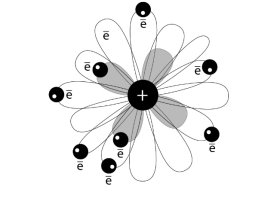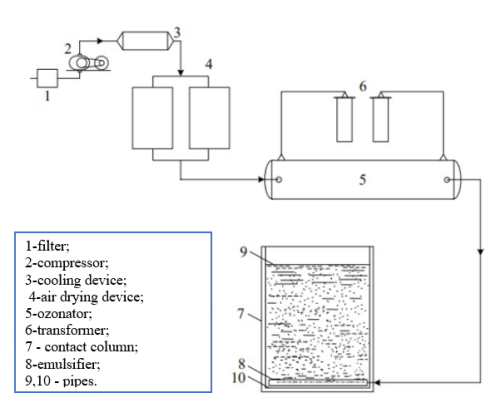In the article, the authors try to explain the essence of the new ion-ozone cavitation technology.
Keywords: ion-ozone technology, ozonized water, ozone, ion technology, ionized water, processed products, environment.
The ecological situation of our planet requires an indispensable economic, ecological and socio-social expediency from modern production. In this regard, the solution to this problem is processes and devices, as well as technological lines of ion-ozone technology, which combines ozone and ion technologies, the agents of which are ozone, molecular and atomic oxygen ions of air, ozonated and ionized liquids of negative and positive polarity, with the possibility of using them separately and in combination, having redox and activating effects. Ion-ozone technology combines many scientific trends of physical and chemical effects, technology, as well as the latest and unique devices for their implementation.
What is ozone and how to get it?
Ozone is an allotropic modification of oxygen at normal temperature and pressure, and is a pale purple gas. In the natural state, ozone is present in the high layers of the atmosphere and occurs photochemically under the influence of solar radiation. There are various methods for producing ozone synthetically, but always dissolved in air or oxygen. Ozone was first obtained by the Dutch chemist Van Marum in 1785 by passing an electric current through oxygen. The Swiss chemist K. F. Schoenbein, in 1840, called ozone the gas he obtained by electric discharge in oxygen.

Fig. 1. Diagram of the molecular structure of ozone
In turn, an ion is an electrically charged particle formed when electrons are lost or attached by atoms, molecules, radicals, etc. Ions can be part of molecules and exist in an incoherent state (in gases, liquids, plasma, etc.)

Fig. 2. Electronic diagram of the molecular ion: е — electron
Ion-ozone technology and devices for its implementation emerged on the basis of scientific achievements of ozone and ion technologies, which reached certain heights with their logically justified, calculated and experimental work. Rational use of the advantages of the components of ion-ozone technology gives not only an economic and environmental effect, but also solves many social and social issues. For example, obtaining an environmentally friendly product.
Ozone does not add anything to the substances subjected to ozonation, which makes it particularly suitable for cleaning some solutions containing pollutants. The use of ion-ozone technology can reduce environmental pollution, reduce energy, material and labor resources. This is especially true when you consider that modern classical technology allows you to process up to 10 % of raw materials into useful products, and the rest goes to waste, losses and waste, polluting the environment to a much greater extent than the increase in useful product.
Application of ion-zone technology in various fields
The scope and scope of the use of ozone and ozonated water, air oxygen ions and ionized water of different polarities have been expanding and increasing rapidly over the past decade. Agents of ion-ozone technology are currently used in areas related to the treatment and disinfection of drinking and industrial water, household fecal and industrial wastewater, as well as in internal combustion engines of rolling stock, etc. in order to reduce biological oxygen consumption, discoloration, neutralize harmful toxic substances, eliminate unpleasant odors, deodorize and purify the air of various industries, ionize and ozonate in air conditioning systems, sterilize packaging and dressing materials in the pharmaceutical industry, therapy and medical prevention of various diseases, increase crop yields with improved quality, increase productivity in animal husbandry and poultry, etc.
An important factor in the processing of food products is the determination of the maximum permissible concentration (MPC) of the redox processes of ionic and hydroionic cavitation necessary for the processing of a particular biological cell, taking into account its structure, acid activity, humidity, ambient temperature, processing method, etc. The study of quantum-physical processes occurring in a biological cell during ionic and hydroionic cavitation treatment of products of biological origin has shown that the oxidation of substances occurs selectively, i.e. biological cells with low resistance, and ions, penetrating into this biological cell, polarize it and increase its biological value.
Ozone and hydrozone mixtures as a result of cavitation are a powerful oxidizer, due to their activity, when mixed with polluted air or purified water, they quickly oxidize pollutants, transferring them from the dissolved state to a suspension, which is easily retained on the mechanical filter. The cleaning process is fast enough, no consumables, materials, maintenance work is required, no harmful impurities are formed in the air and in the water, the mineral composition and PH level are preserved, in other words, ozone or hydrozone cleaning is absolutely environmentally friendly and safe. Having a high sterilizing capacity, ozone or hydrozone mixture with cavitation has a decontaminating effect on pathogens, including spores resistant to chlorine treatment. Ozonated water is used with great success in the food and processing industry, as well as in agricultural industries.
The Almaty Technological University has developed and is developing ion-ozonator and ozonator installations, installations for ozonation and ionization of water structures separately, a universal ion-ozone installation that produces ozone and oxygen ions in the air, ozonated and ionized water of different polarities without any accompanying harmful impurities, and also conducts research and experimental work on the processing, processing and preservation of products of biological origin.
The efficiency of ion ozone installations such as Bateson 1, Batson 2, 3 Bateson, Nemerov APK-1, Inosanto achieved by improving the electrical circuits, material selection, calculation of the geometric dimensions and proportions. According to the calculations and experimental research, the optimal modes of synthesis of ozone and oxygen ions in the air, the parameters of the impact on the processed products were established.
Let's consider the basic technological scheme of ozonation in Figure 3

Fig. 3. Basic technological scheme of the ozonizing plant
The use of ozone and other agents of ion-ozone technology is promising for the following reasons:
– high oxidation potential of ozone and ion (second only to fluorine and unstable radicals, but unlike fluorine and other oxidants ozone and ions have the recovery factor of the processed biological product, i.e. increasing the biological value of the product and improve the organoleptic and physico-chemical properties);
– the possibility of obtaining ozone and ions, as well as ozonated and ionized water at the place of consumption, even in places where there is no electricity (it is enough to connect an electronic set-top box to a car of any brand);
– ease and availability of obtaining agents of ion-ozone technology in electronic devices-ozonators, installations for obtaining ozonated water, etc.;
– waste-free production, no cumulative harmful substances;
– economic feasibility — the cost of ozone and other agents is 2–3 times lower than the cost of other oxidizing agents (for example, chlorine);
– environmental compatibility of ozone and other agents of ion-ozone technology with the environment and humans.
Thus, the use of ozone and other agents of ion-ozone technologies will allow to organic food, enhancing its biological value with the transfer by inheritance of acquired positive qualities, creates favorable conditions for efficient work, improve the sanitary conditions, enables to reduce the cost of the processed product.
References:
- Iskakova G. K., Iztayev A. I., Kulazhanov because Iztayev B. A., M. M. Maiorov Technology of bread and pasta with the use of ozonated water and indosinian: monograph, Almaty: ATU, 2011. — 216.
- Kulazhanov K. S., Kartalova M. S., Iztayev I. A., Iskakova G. K., baltabayeva B., the Use of ozonated water in bread making when processing defective flour: article — 2011.
- Maemerov M. M., Iztaev A. I., Kulazhanov T. K., Iskakova G. K. Scientific bases of ion-zone technology of grain processing and products of its processing (monograph). — Almaty: Aleyron, 2011. -246 p.
- Maemerov M. M., Iskakova G. K., Kozhakhmetova I. I. Influence of ion-ozonated water on the quality of national bakery products / «Bulletin of the Almaty Technological University». — 2012. — No. 2. — p. 23–25
- Iskakova G. K., Iztaev B. A., Kuanyshbekova K. Research of physical and biochemical properties of new varieties of soft and durum wheat of Kazakhstan/ «Bulletin of Almaty Technological University». — 2012. — No. 4. — p. 53–58
- Iztaev A. I., Iskakova G. K., Kulazhanov T. K., Iztaev B. A., Mayemerov M. M. Technology of bread and pasta with the use of ozonated and ion-ozonated water. Monograph. «LEM» Publishing House Almaty, 2012 216 p.
- Iztaev A. I., Kulazhanov T. K., Iskakova G. K. Scientific bases of ion-zone technology of grain processing and products of its processing. Monograph. LEM Publishing House»Almaty, 2012. 246 p.
- Iztaev A. I., Urazaliev R. A., Kulazhanov T. K., Maemerov M. M., Iztaev B. A., Yakiyaeva M. A. Bioenergetic and ecological processes of increasing the yield, seed and technological qualities of grain. Monograph. Almaty: LLP «LEM Publishing», 2017. — 236 p.
- Iztayev A. I., lobster I. e., Izmukhambetov J. D., kozhakhmetova, F. K., G. B. Sarsenbayeva, Mametova Z. K., Iztayev B. A. the Effect of disinfection by ozone and air mixture to reduce the activity of pests and to improve the quality of wheat // Information of agricultural technology: proc. Dokl. mezhdun. nauch.-practical. of the seminar. — Almaty, 2009. — p. 93.
- Iztaev A. I., Kulazhanov T. K., Saparbayev A. D. Innovative technologies and logistics of agro-industrial complex processing industries. — Almaty:LLP «Fortuna polygraph». 2019–752 p.

